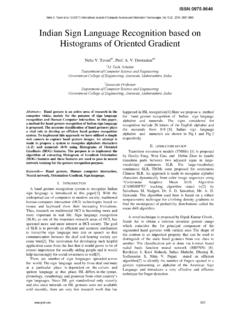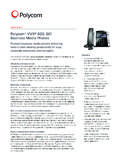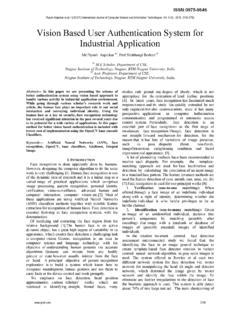Transcription of Chapter 4
1 SOCIAL INTERACTIONC hapter 4 ObjectivesThe main aims of this Chapter are to: Explain what is meant by social interaction. Describe the social mechanisms that are used by people when communicating and collaborating. Discuss how social media have changed the ways in which we keep in touch, make contact, and manage our social and working lives. Explain what is meant by telepresence. Give an overview of shareable technologies and some of the studies showing how they can facilitate collaboration and group Being Face-to-Face Remote IntroductionImagine not having access to your smartphone or the Internet for a week.
2 How would you cope? Would you get bored, start twitching, or even go stir crazy? Would you feel isolated and be constantly wondering what is happening in your online social network? Many people now cannot go for very long without checking for messages, the latest tweets, Facebook updates, emails, etc. even when on vacation. For many, checking their phone is the fi rst thing they do when waking up. It has become a daily routine and an integral part of their social lives. This is not surprising given that humans are inherently social: they live together, work together, learn together, play together, interact and talk with each other, and BEING SOCIAL101 There are many kinds of sociality and many ways of studying it.
3 In this Chapter our focus is on how people communicate and collaborate in their social, work, and everyday lives. We examine how the emergence of a diversity of communication technologies has changed the way people live the way they keep in touch, make friends, and coordinate their social and work networks. We look at the conversation mechanisms that have conven-tionally been used in face-to-face interactions and examine how these have changed for the various kinds of computer-based conversations that take place at a distance. We describe the idea of telepresence, where novel technologies have been designed to allow a person to feel as if they are present or to give the appearance of being present at another loca-tion.
4 We also outline some technologies that have been developed to enable new forms of interaction, focusing on how shareable technologies can facilitate and support collocated Being SocialA fundamental aspect of everyday life is being social interacting with each other. We con-tinuously update each other about news, changes, and developments on a given project, activity, person, or event. For example, friends and families keep each other posted on what s happening at work, at school, at the pub, at the club, next door, in soap operas, and in the news. Similarly, people who work together keep each other informed about their social lives and everyday happenings, as well as what is happening at work, for instance when a project is about to be completed, plans for a new project, problems with meeting deadlines, rumors about closures, and so face-to-face conversations remain central to many of our social interactions , the use of social media has dramatically increased.
5 Many of us now routinely spend several hours a day communicating online texting, emailing, tweeting, Facebooking, Skyping, using Yammer, instant messaging, and so on. The almost universal uptake of social media in mainstream life has resulted in many people now being connected in multiple ways over time and space in ways unimaginable 25 or even 10 years ago. For example, the average number of friends adults have on Facebook was 338 in 2014 (Pew Research), while many people have over 500 or more work connections in LinkedIn many more than those made through face-to-face networking.
6 The way we make contact, how we stay in touch, who we connect to, and how we maintain our social networks and family ties have irrevocably key question this raises is how do we cope with the dramatic increase in networking in our daily lives? Are the ways we live and interact with one another changing? Have the conventions, norms, and rules established in face-to-face interactions to maintain social order been adopted in social media interactions ? Or have new norms emerged? In particular, are the established conversational rules and etiquette whose function it is to let people know how they should behave in social groups also applicable to online social behavior?
7 Or, have new conversational mechanisms evolved for the various kinds of social media? For example, do people greet each other in the same way, depending on whether they are chatting online, Skyping, or at a party? Do people take turns when online chatting in the way they do when talking with each other face-to-face? How do people choose which technology or app to use from the diversity available today for their various work and social activities; for example, 4 SOCIAL INTERACTION102 SnapChat, WhatsApp, text message, Skype, or phone call? In order to answer these questions we next describe the core social mechanisms that exist in face-to-face interactions , followed by a discussion of the extent to which they remain or have been replaced with other mech-anisms in online Face-to-Face ConversationsTalking is something that is effortless and comes naturally to most people.
8 And yet holding a conversation is a highly skilled collaborative achievement, having many of the qualities of a musical ensemble. Below we examine what makes up a conversation. We begin by examining what happens at the beginning:A: Hi : Hi!C: : All right?C: Good. How s it going?A: Fine, how are you?C: : OK. How s life treating you?Such mutual greetings are typical. A dialog may then ensue in which the participants take turns asking questions, giving replies, and making statements. Then when one or more of the participants wants to draw the conversation to a close, they do so by using either implicit or explicit cues.
9 An example of an implicit cue is when a participant looks at his watch, signaling indirectly to the other participants that he wants the conversation to draw to a close. The other participants may choose to acknowledge this cue or carry on and ignore it. Either way, the fi rst participant may then offer an explicit signal, by saying, Well, I must be off now. Got work to do or, Oh dear, look at the time. Must dash. Have to meet someone. Following the acknowledgment by the other participants of such implicit and explicit sig-nals, the conversation draws to a close, with a farewell ritual.
10 The different participants take turns saying, Bye, Bye then, See you, repeating themselves several times, until they fi nally do you start and end a conversation when (i) talking on a phone and (ii) chatting online?CommentThe person answering the call will initiate the conversation by saying hello or, more formally, the name of their company/department (and sometimes the phone number being called). Most FACE-TO-FACE CONVERSATIONS103 These conversational mechanisms enable people to coordinate their talk with one another, allowing them to know how to start and stop.




